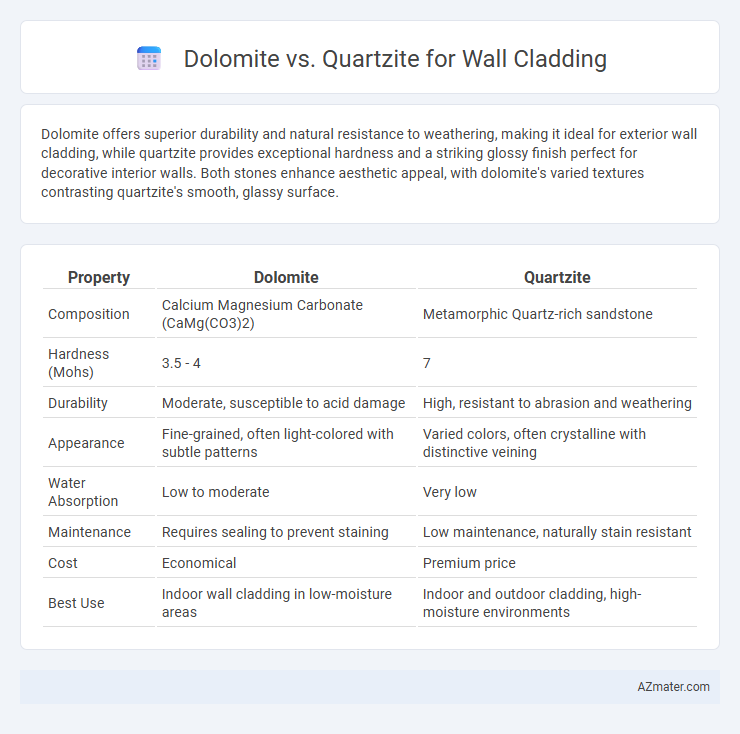Dolomite offers superior durability and natural resistance to weathering, making it ideal for exterior wall cladding, while quartzite provides exceptional hardness and a striking glossy finish perfect for decorative interior walls. Both stones enhance aesthetic appeal, with dolomite's varied textures contrasting quartzite's smooth, glassy surface.
Table of Comparison
| Property | Dolomite | Quartzite |
|---|---|---|
| Composition | Calcium Magnesium Carbonate (CaMg(CO3)2) | Metamorphic Quartz-rich sandstone |
| Hardness (Mohs) | 3.5 - 4 | 7 |
| Durability | Moderate, susceptible to acid damage | High, resistant to abrasion and weathering |
| Appearance | Fine-grained, often light-colored with subtle patterns | Varied colors, often crystalline with distinctive veining |
| Water Absorption | Low to moderate | Very low |
| Maintenance | Requires sealing to prevent staining | Low maintenance, naturally stain resistant |
| Cost | Economical | Premium price |
| Best Use | Indoor wall cladding in low-moisture areas | Indoor and outdoor cladding, high-moisture environments |
Introduction to Dolomite and Quartzite for Wall Cladding
Dolomite is a sedimentary carbonate rock composed primarily of the mineral dolomite, prized for its durability, resistance to weathering, and attractive soft hues, making it a popular choice for wall cladding in both interior and exterior applications. Quartzite, a metamorphic rock formed from sandstone, is renowned for its hardness, scratch resistance, and natural sparkling texture, offering a sleek and robust option for wall surfaces. Both materials provide unique aesthetic and structural benefits, with dolomite favoring elegance and quartzite excelling in strength and longevity for wall cladding projects.
Geological Formation and Composition
Dolomite forms primarily through the sedimentary process of dolomitization, where magnesium-rich fluids alter limestone, resulting in a calcium magnesium carbonate composition (CaMg(CO3)2). Quartzite originates from the metamorphism of quartz-rich sandstone, composed almost entirely of recrystallized quartz grains (SiO2), giving it exceptional hardness and resistance. These distinct geological formations influence their durability and aesthetic appeal, with dolomite offering a more varied texture due to its carbonate content and quartzite providing superior strength and a glassy luster from its high silica makeup.
Aesthetic Appeal: Colors and Patterns
Dolomite for wall cladding showcases soft, muted tones with subtle veining, lending an elegant and understated aesthetic ideal for minimalist or classical interiors. Quartzite offers a broader color palette, including whites, grays, pinks, and blues, with striking, intricate patterns that create dynamic visual interest and a sense of luxury. The choice between Dolomite and Quartzite hinges on desired ambiance: Dolomite's restrained beauty suits serene settings, while Quartzite's vivid patterns enhance bold, contemporary designs.
Durability and Strength Comparison
Dolomite exhibits high durability and resistance to abrasion, making it suitable for wall cladding in moderate environments, though it is generally softer than quartzite. Quartzite boasts superior strength and hardness due to its metamorphic nature, offering exceptional resistance to weathering, impact, and pressure, which ensures long-lasting performance for exterior and high-traffic areas. The dense crystalline structure of quartzite makes it more resilient against chipping and cracking compared to dolomite, thus preferred for demanding architectural applications.
Weather and Moisture Resistance
Dolomite exhibits excellent weather resistance due to its crystalline structure, making it highly durable against rain and temperature fluctuations for wall cladding. Quartzite offers superior moisture resistance because of its dense composition and low porosity, preventing water absorption and reducing the risk of mold or mildew. Both materials perform well outdoors, but quartzite's higher impermeability makes it a preferred choice in high-humidity environments.
Maintenance Requirements
Dolomite wall cladding requires minimal maintenance due to its natural resistance to weathering and erosion, making it suitable for outdoor applications with occasional cleaning to preserve its appearance. Quartzite, being a denser and harder material, offers superior durability and requires less frequent maintenance but benefits from periodic sealing to prevent staining and maintain its polished finish. Both materials are low-maintenance options for wall cladding, with quartzite providing enhanced protection against wear and dolomite offering ease of upkeep in various environmental conditions.
Cost Analysis: Dolomite vs Quartzite
Dolomite wall cladding generally offers a more cost-effective solution compared to quartzite, with prices averaging between $7 to $15 per square foot versus quartzite's $20 to $40 per square foot. The affordability of dolomite stems from its abundant availability and easier quarrying processes, reducing both material and installation expenses. Quartzite's higher cost is justified by its superior hardness and durability, making it a premium choice for long-lasting, impact-resistant wall cladding projects.
Installation Process and Considerations
Dolomite and quartzite differ significantly in their installation processes due to variations in hardness and porosity; quartzite's extreme hardness demands specialized tools and slower cutting techniques to avoid chipping, while dolomite's moderate hardness allows for easier handling and quicker installation. Moisture absorption rates influence considerations, with dolomite requiring thorough sealing to prevent staining and quartzite benefiting from its natural resistance but still needing periodic maintenance. Weight and structural support factors are critical as quartzite's higher density requires reinforced anchoring systems compared to the lighter dolomite panels.
Environmental Impact and Sustainability
Dolomite wall cladding offers a lower environmental footprint due to its abundant availability and less intensive mining process compared to quartzite, which requires more energy-consuming extraction and processing. Quartzite, known for its durability and resistance to weathering, contributes to sustainability by reducing the need for frequent replacements, thus minimizing long-term resource consumption. Both materials are recyclable and natural stone options, but dolomite's reduced carbon emissions during production make it a more eco-friendly choice for sustainable architecture.
Ideal Applications and Design Inspirations
Dolomite offers a sleek, smooth texture ideal for modern interior wall cladding, especially in living rooms and commercial spaces where subtle elegance is desired. Quartzite, known for its durability and vibrant natural patterns, excels in high-traffic areas like kitchens and feature walls, providing both aesthetic appeal and long-lasting performance. Design inspirations include combining Dolomite's neutral tones with minimalist decor for a sophisticated look, while Quartzite's dynamic veining complements rustic, industrial, or eclectic styles.

Infographic: Dolomite vs Quartzite for Wall Cladding
 azmater.com
azmater.com